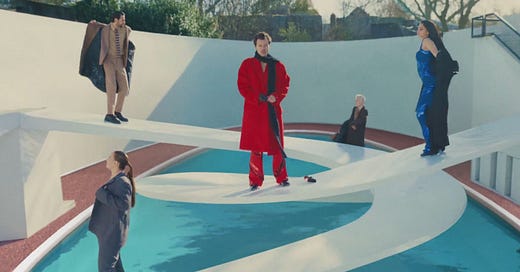Heya friends, happy Friday!
Wrote this newsletter ~jamming~ to Harry Styles’ new bop / music video that features some of my favourite architectural landmarks in London, namely the Barbican (classic) and the penguin pool at the London Zoo (iconic). If you want to listen along while you read, I think it’d be very apropos.
If you want to learn about how cool the architecture scene of the London Zoo is (I know you do!!), this article gives a great overview, while this one covers modernism design specifically, and finally the V&A go deep into the intricacies of the penguin pool specifically. Enjoy!
Read of the Week
The promise of the 15-minute city
A fairly optimistic view on 15-minute cities, with the harshest critique contemplating if 15-minute cities have staying power or will just be another fad in the urban planning ecosystem. The article mostly questions the concept’s novelty and feasibility, missing more poignant critiques related to classism, displacement, and inequities. See Edward Glaeser’s opinion piece from LSE Cities as an example.
It’s important to avoid labelling any one form of urban policy as a “silver bullet” solution, because with every policy change there are winner and losers. And while we may expect the “car” to be the automatic loser in a 15-minute city, this simplistic view on what is an incredibly nuanced and complicated concept shuts out deeper questions of who these program benefit most, and who becomes harmed by these policies.
Government and Policy
US introduces stricter tailpipe emission standards
USDOT estimate that the measures could prevent 5.5 trillion pounds of carbon dioxide from going into our atmosphere between now and 2050. While encouraging, and a roll in the right direction, I’m still waiting for some major rail, public transit, + active travel budgets to further minimize the necessity of driving in America. Designing a better car solves few problems. Designing better transport networks is where we really win on climate impact.
Montreal’s mega commitment to streets for people
Montreal is taking their successful summer street pilot and putting a ring on it. Summer streets will now be official programs with permits for three years, a measure to simplify the permitting process. Sounds very dreamy to me.
Oakland’s universal basic mobility pilot
Last year Oakland piloted a year long universal basic mobility program to increase transit, walking, biking and shared mobility across the city. The program provided 500 restricted and prepaid debit cards, each containing up to $300, that participants could use to purchase trips on public transit, bike share, and scooters.
“In a mid-program survey, 40% of participants said they changed how they travel, with 23% saying they drove alone less often. “Participants rode transit more and drove less as their primary mode of transportation for [commuting] and other trips,” according to the survey.”
You can read the official program evaluation here.
Industry
A cute n kitschy “solution”. The Times (never not behind a paywall, sadly) has a story about Oxbotica’s most recent UK trial where their shuttles will communicate with other road users via … emojis.
“In the US, pilot schemes run by technology companies have concentrated on personal “robo-taxis”, picking up individual passengers from any point and delivering them to any destination, but Britain is taking a different approach.”
Another week where if you opened a single newsletter / google alert you were bombarded with news about Waymo’s AV trial in San Francisco removing drivers. The above link is for a video of the vehicle navigating city streets. It’s exactly as you’d expect, so if you’re in the mood for some store-bought marketing, please enjoy!
Research and Academia
How AV policy impacts social equity
New research from the University of Minnesota, Twin Cities consider the impact of AV policy on social equity, and I am here for this oft overlooked discussion / analysis. Findings include:
Policymakers are beginning to plan for the potential equity impacts of AVs, but more opportunities remain for developing policies that will ensure the most equitable outcomes.
Policies addressing shared AVs and the economic impacts of AVs were somewhat common at the local and state levels, as were policy recommendations provided by nonprofit organizations.
Few policies would support deployment of AVs in ways that address interpersonal security in the shared setting, nor the transportation needs of low-income people, people of color or rural residents.
Opinion
Imagining Los Angeles without traffic
“To start, we can put exclusive bus lanes and protected bike lanes on our major thoroughfares. Then we can run more and faster bus service, expand our bike share programs, and perhaps even distribute bicycles to those who cannot afford them. We can ensure sidewalks on every street and curb cuts on every corner, plus bus shelters to protect waiting passengers from the sun. We can lower speed limits even more on city streets, enforce traffic laws, and create more pedestrian crosswalks that give people more time to cross.
Then we get to the hard part: We need to stop giving away roadway space for free.”
Extra Bits + Bobs
SUMC is back! The Shared Use Mobility Conference is back, and this time in person, in Chicago on May 17 & 18. You can register here!
That’s all from me. Have a beautiful weekend friends.
Sarah





